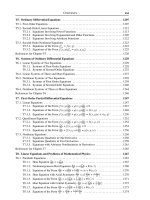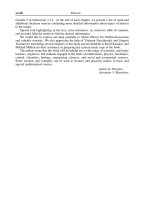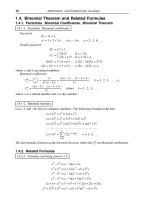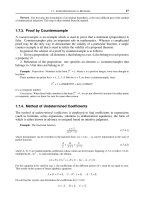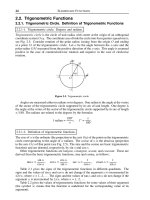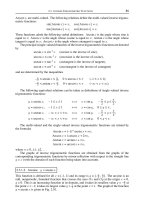Handbook of mathematics for engineers and scienteists part 18 pptx
Bạn đang xem bản rút gọn của tài liệu. Xem và tải ngay bản đầy đủ của tài liệu tại đây (380.1 KB, 7 trang )
4.2. CURVES ON PLANE 87
4.2.1-5. Parametric equations of a curve.
Parametric equations of a curve on the plane have the form
x = ϕ(t), y = ψ(t), (4.2.1.4)
where x and y are treated as the coordinates of some point A for each value of the variable
parameter t. In general, the variables x and y vary with t, and the point A moves on the
plane.
Parametric equations play an important role in applied mathematics and mechanics,
where they are called the equations of motion of a mass point. The parameter t has the
meaning of time.
Remark 1. Eliminating the parameter t from equations (4.2.1.4), we obtain an equation of the curve in
the form (4.2.1.1).
Remark 2. In different problems, the variable parameter in equations (4.2.1.4) may have different mean-
ings.
Example 11. Thecircleofradiusa centered at the origin is described by the following parametric equations
for the Cartesian system:
x = a cos t, y = a sin t.
By squaring these equations and by adding them, we obtain the equation of the circle in the form
x
2
+ y
2
= a
2
.
Example 12. The spiral of Archimedes (a), the hyperbolic spiral (b), and the logarithmic spiral (c)are
described by the following equations in the polar coordinate system:
(a) ρ = aθ;(b) ρ =
a
θ
;(c) ρ = a
θ
.
The parametric equations for the Cartesian coordinates of these curves have the form
(a) x = aθ cos θ, y = aθ sin θ;
(b) x =
a cos θ
θ
, y =
a sin θ
θ
;
(c) x = a
θ
cos θ, y = a
θ
sin θ.
In all three cases, the variable parameter is the polar angle θ.
4.2.1-6. Algebraic curves.
The curves given by algebraic equations of the form
Ax + By + C = 0,
Ax
2
+ Bxy + Cy
2
+ Dx + Ey + F = 0,
Ax
3
+ Bx
2
y + Cxy
2
+ Dy
3
+ Ex
2
+ Fxy+ Gy
2
+ Hx + Iy + K = 0,
(4.2.1.5)
in a rectangular Cartesian coordinate system are called algebraic curves on the plane.
A curve given by an algebraic equation of degree n in a rectangular Cartesian coordinate
system is called an nth-order algebraic curve.
When passing from one rectangular Cartesian coordinate system to another, the degree
of the equation of an algebraic curve does not change; i.e., any nth-order algebraic curve
remains such in any rectangular Cartesian coordinate system.
88 ANALYTIC GEOMETRY
4.2.2. Main Problems of Analytic Geometry for Curves
4.2.2-1. Construction of equation for given curve.
Suppose that a curve is defined on the plane as a locus of points and one needs to construct
an equation of this curve. This is the first main problem of analytic geometry for curves.
Example 1. Suppose that a circle of radius R is given on the plane. In the rectangular Cartesian coordinate
system OXY , its origin is point A(x
0
, y
0
). It is required to derive an equation of this circle (see Fig. 4.12a).
X
Y
O
A
R
B
y=x
()a ()b
O
X
Y
Figure 4.12. Construction of equation for given curve (a) and construction of curve with given equation (b).
By B(x, y) we denote the variable point of the circle. Obviously, the circle is the locus of points lying at
the distance R from the point A(x
0
, y
0
); i.e., AB = R,or
(x – x
0
)
2
+(y – y
0
)
2
= R.
This is the desired equation of the circle of radius R centered at the point A(x
0
, y
0
), which is usually written as
(x – x
0
)
2
+(y – y
0
)
2
= R
2
.
4.2.2-2. Construction of curve with given equation.
Suppose that an equation with two variables is given and one needs to construct the curve
determined by this equation on the plane. This is the second main problem of analytic
geometry for curves.
Example 2. Consider the equation x – y = 0 or y = x. The points whose coordinates satisfy this equation
lie in the first and third quadrants at equal distances from the coordinate axes. Thus the locus of points whose
coordinates satisfy this equation is the bisector of the first and third coordinate angles (see Fig. 4.12b).
4.2.2-3. Intersection of two curves.
Consider two curves determined by the equations
F (x, y)=0, G(x, y)=0.(4.2.2.1)
To find the points of intersection of these curves, one solves system (4.2.2.1). Each real
solution of this system gives a point of intersection. If the system is inconsistent or does
not have real solutions, then the curves do not meet.
Example 3. Let us find the points of intersection of two curves (a circle and a straight line) with the
equations
x
2
+ y
2
– 25 = 0, 2x – y + 5 = 0.
These equations form a system of two equations with two unknowns. For example, if we express y from the
second equation and substitute the resulting expression into the first equation, then we obtain x
2
+4x = 0, whence
we find x
1
= 0, x
2
=–4 and y
1
= 5, y
2
=–3. This means that the curves have two points of intersection, (0, 5)
and (–4,–3).
Remark. For equations (4.2.2.1) written, for example, in a polar coordinate system, it is natural to use ρ
and θ instead of the variables x and y.
4.3. STRAIGHT LINES AND POINTS ON PLANE 89
4.3. Straight Lines and Points on Plane
4.3.1. Equations of Straight Lines on Plane
4.3.1-1. Slope-intercept equation of straight line.
The tangent of the angle of inclination of a straight line to the axis OX is called the slope
of the straight line. The slope characterizes the direction of the line. For straight lines
perpendicular to the OX-axis, slope does not make sense, although one often says that the
slope of such straight lines is equal to infinity.
The slope-intercept equation of a straight line in the rectangular Cartesian coordinate
system OXY has the form
y = kx + b,(4.3.1.1)
where k =tanϕ =(y – b)/x is the slope of the line and b is the y-intercept of the line, i.e.,
the signed distance from the point of intersection of the line with the ordinate axis to the
origin. Equation (4.3.1.1) is meaningful for any straight line that is not perpendicular to the
abscissa axis (see Fig. 4.13a).
X
b
y = kx+b x a=
φ
Y
O
a
()a ()b
X
Y
O
Figure 4.13. Straight lines on plane.
If a straight line is not perpendicular to the OX-axis, then its equation can be written
as (4.3.1.1), but if a straight line is perpendicular to the OX-axis, then its equation can be
written as
x = a,(4.3.1.2)
where a is the abscissa of the point of intersection of this line with the OX-axis (see
Fig. 4.13b).
For the slope of a straight line, we also have the formula
k =
y
2
– y
1
x
2
– x
1
,(4.3.1.3)
where A
1
(x
1
, y
1
)andA
2
(x
2
, y
2
) are two arbitrary points of the line.
4.3.1-2. Point-slope equation of straight line.
In the rectangular Cartesian coordinate system OXY , the equation of a straight line with
slope k passing through a point A(x
1
, y
1
)hastheform
y – y
1
= k(x – x
1
). (4.3.1.4)
Remark. If we set x
1
= 0 and y
1
= b in equation (4.3.1.4), then we obtain equation (4.3.1.1).
90 ANALYTIC GEOMETRY
4.3.1-3. Equation of straight line passing through two given points.
In the rectangular Cartesian coordinate system OXY , the equation of a straight line with
slope k passing through points A
1
(x
1
, y
1
)andA
2
(x
2
, y
2
) has the form (4.3.1.4), where k is
given by the expression (4.3.1.3):
y – y
1
=
y
2
– y
1
x
2
– x
1
(x – x
1
). (4.3.1.5)
This equation is usually written as
x – x
1
x
2
– x
1
=
y – y
1
y
2
– y
1
.(4.3.1.6)
Equation (4.3.1.6) is also called the canonical equation of the straight line passing through
two given points on the plane.
Sometimes one writes this equation in terms of a third-order determinant as follows:
xy1
x
1
y
1
1
x
2
y
2
1
= 0.(4.3.1.7)
Example 1. Let us derive the equation of the straight line passing through the points A
1
(5, 1)andA
2
(7, 3).
Substituting the coordinates of these points into formula (4.3.1.5), we obtain
x – 5
2
=
y – 1
2
or y = x – 4.
4.3.1-4. General equation of straight line on plane.
An equation of the form
Ax + By + C = 0 (4.3.1.8)
is called the general equation of a straight line in the rectangular Cartesian coordinate
system OXY . In rectangular Cartesian coordinates, each straight line is determined by an
equation of degree 1, and, conversely, each equation of degree 1 determines a straight line.
If B ≠ 0, then equation (4.3.1.8) can be written as (4.3.1.1), where k =–A/B and
b =–C/B.IfB = 0, then equation (4.3.1.8) can be written as (4.3.1.2), where a =–C/A.
If C = 0, then the equation of a straight line becomes Ax + By = 0 and determines a
straight line passing through the origin.
If B = 0 and A ≠ 0, then the equation of a straight line becomes Ax + C = 0 and
determines a straight line parallel to the axis OY .
If A = 0 and B ≠ 0, then the equation of a straight line becomes By + C = 0 and
determines a straight line parallel to the axis OX.
4.3.1-5. General equation of straight line passing through given points on plane.
In the rectangular Cartesian coordinate system OXY , the general equation of a straight line
passing through the point A(x
1
, y
1
) on the plane has the form
A(x – x
1
)+B(y – y
1
)=0.(4.3.1.9)
If this equation is written in the form
x – x
1
B
=
y – y
1
–A
,(4.3.1.10)
then it is called the canonical equation of a straight line passing through a given point on
the plane.IfB = 0, then one sets x – x
0
= 0,andifA = 0, then one sets y – y
0
= 0.
Remark. The general equation of the straight line passing through two given points on the plane has the
form (4.3.1.6).
4.3. STRAIGHT LINES AND POINTS ON PLANE 91
4.3.1-6. Parametric equations of straight line on plane.
The parametric equations of a straight line on the plane through the point A(x
1
, y
1
)inthe
rectangular Cartesian coordinate system OXY have the form
x = x
1
+ Bt, y = y
1
– At,(4.3.1.11)
where A and B are the coefficients of the general equation (4.3.1.8) or (4.3.1.9) of a straight
line and t is a variable parameter.
In the rectangular Cartesian coordinate system OXY , the parametric equations of the
straight line passing through two points A(x
1
, y
1
)andA(x
2
, y
2
) on the plane can be written
as
x = x
1
(1 – t)+x
2
t,
y = y
1
(1 – t)–y
2
t.
(4.3.1.12)
Remark. Eliminating the parameter t from equations (4.3.1.11) and (4.3.1.12), we obtain equations
(4.3.1.9) and (4.3.1.6), respectively.
4.3.1-7. Intercept-intercept equation of straight line.
The intercept-intercept equation of a straight line in the rectangular Cartesian coordinate
system OXY has the form
x
a
+
y
b
= 1,(4.3.1.13)
where a and b are the x-andy-intercepts of the line, i.e., the signed distances from the
points of intersection of the line with the coordinate axes to the origin (see Fig. 4.14).
X
a
b
Y
O
Figure 4.14. A straight line with intercept-intercept equation.
4.3.1-8. Normalized equation of straight line.
Suppose that a rectangular Cartesian coordinate system OXY and a straight line are given
on the plane. We draw the perpendicular to the straight line through the origin. This
perpendicular is called the normal to the line. By P we denote the point of intersection of
the normal with the line.
The equation
x cos α + y sin α – p = 0,(4.3.1.14)
where α is the polar angle of the normal and p is the length of the segment OP (the distance
from the origin to the straight line) (see Fig. 4.15), is called the normalized equation of
92 ANALYTIC GEOMETRY
X
α
p
Y
O
P
Figure 4.15. A straight line with normalized equation.
the straight line in the rectangular Cartesian coordinate system OXY . In the normalized
equation of a straight line, p ≥ 0 and cos
2
α +sin
2
α = 1.
For all positions of the straight line with respect to the coordinate axes, its equation can
always be written in normalized form.
The general equation of a straight line (4.3.1.8) can be reduced to a normalized
form (4.3.1.14) by setting
cos α =
A
√
A
2
+ B
2
,sinα =
B
√
A
2
+ B
2
, p =
C
√
A
2
+ B
2
,(4.3.1.15)
where the upper sign is taken for C < 0 and the lower sign for C > 0.ForC = 0, either sign
can be taken.
4.3.1-9. Equation of straight line in polar coordinates.
The equation of a straight line in polar coordinates can be written as
ρ cos(θ – α)=p ,(4.3.1.16)
where ρ and θ are the polar radius and the polar angle of the current point B of the straight
line, α is the polar angle of the normal, and p is the distance from the pole to the line (see
Fig. 4.16).
X
α
θ
p
ρ
O
B
Figure 4.16. A straight line with equation in polar coordinates.
4.3.1-10. Equation of a pencil of straight lines.
The set of all straight lines passing through a point A on the plane is called a pencil of straight
lines, and the point A itself is called the center of the pencil. The equations determining all
straight lines in the pencil are called equations of the pencil.
4.3. STRAIGHT LINES AND POINTS ON PLANE 93
1
◦
. If the Cartesian coordinates of the pencil center A(x
0
, y
0
) are known, then the equation
of any straight line in the pencil that is not parallel to the OY -axis has the form
y – y
0
= k(x – x
0
), (4.3.1.17)
where k is the slope of the straight line. For the straight line in the pencil parallel to the
OY -axis,
x = x
0
.(4.3.1.18)
2
◦
. If the equations of two straight lines in the pencil are known, for example, A
1
x +B
1
y +
C
1
= 0 and A
2
x + B
2
y + C
2
= 0, then the equation of the pencil can be written as
α(A
1
x + B
1
y + C
1
)+β(A
2
x + B
2
y + C
2
)=0,(4.3.1.19)
where α and β are any numbers that are not simultaneously zero.
4.3.2. Mutual Arrangement of Points and Straight Lines
4.3.2-1. Condition for three points to be collinear.
Suppose that points A
1
(x
1
, y
1
), A
2
(x
2
, y
2
), and A
3
(x
3
, y
3
) are given in the Cartesian coor-
dinate system OXY on the planes. They are collinear (lie on the same straight line) if and
only if
x
3
– x
1
x
2
– x
1
=
y
3
– y
1
y
2
– y
1
.(4.3.2.1)
4.3.2-2. Deviation of point from straight line.
The number δ, equal to the length of the perpendicular to a straight line through a point
taken with the plus sign if the point and the origin lie on opposite sides of the line and with
the minus sign otherwise, is called the deviation of the point from the line. Obviously, the
deviation is zero for points lying on the line.
To find the deviation of a point A(x
0
, y
0
) from a straight line, one substitutes the
coordinates of A into the left-hand side of the normalized equation of the line (see Para-
graph 4.3.1-8) for the current Cartesian coordinates:
δ = x
0
cos α + y
0
sin α – p.(4.3.2.2)
4.3.2-3. Distance from point to straight line.
The distance d from a point to a straight line is the absolute value of the deviation. It can
be calculated by the formula
d = |x
0
cos α + y
0
sin α – p |.(4.3.2.3)
The distance from a point A(x
0
, y
0
) to a straight line given by the general equation
Ax + By + C = 0 can be calculated by the formula
d =
|Ax
0
+ By
0
+ C |
√
A
2
+ B
2
.(4.3.2.4)
Example 1. Let us find the distance from the point A(2, 1) to the straight line 3x + 4y + 5 = 0.Weuse
formula (4.3.2.4) to obtain
d =
|Ax
0
+ By
0
+ C|
√
A
2
+ B
2
=
|3 ⋅ 2 + 4 ⋅ 1 + 5|
√
3
2
+ 4
2
=
15
5
= 3.



